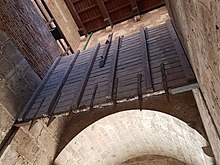Portcullis


A portcullis (from
Old French porte coleice 'sliding gate')[1] is a heavy, vertically closing gate typically found in medieval fortifications, consisting of a latticed grille
made of wood and/or metal, which slides down grooves inset within each jamb of the gateway.
Usage

Portcullises fortified the entrances to many
medieval castles, securely closing off the castle during time of attack or siege. Every portcullis was mounted in vertical grooves in the walls of the castle and could be raised or lowered quickly by means of chains or ropes attached to an internal winch
.
Portcullises had an advantage over standard gates in that they could be closed immediately at a time of crisis by a single guard.
Often, two portcullises to the main
archers and crossbowmen
to kill the trapped group of attackers.
In England, working portcullises survive at the
Monk Bar in York, Hever Castle in Kent, and at the hotel conversion, Amberley Castle.[3][4] In Scotland, a working portcullis is at Edinburgh Castle
.
Heraldry

The portcullis was the heraldic badge of the
Royal badges of the House of Tudor. Since then, the portcullis has been a moderately common motif of English heraldry, especially that heraldry dating from the Tudor period. The heraldic office of Portcullis Pursuivant of Arms in Ordinary, a junior officer of arms in the College of Arms at London
, dates from this period.
Through
Cape Colony and named them for his family. These include Worcester, Somerset West, Fort Beaufort, and Beaufort West. Institutions that derive the portcullis from these arms include a school, a chamber of commerce, and a rugby club. Other (around 30) South African coats of arms that include a portcullis are not necessarily related to either Lord
Charles Somerset or any of the towns named after and by him.

Although the
Henry VIII until 1530, the current use of the portcullis as a symbol of the palace and of Parliament does not date from that time. Rather, the symbol was developed as part of Sir Charles Barry's plans for the rebuilt palace after the original burned down on 16 October 1834; he conceptualized the new palace as a "legislative castle", and the symbol of a castle gate—i.e. a portcullis—fit well with the scheme.[5][6]
Since then, the portcullis has become the primary symbol of Parliament; an office building for
coat of arms of Canberra features a portcullis in its crest, preserving a connection between the British Parliament at Westminster and the Australian Parliament
to which Canberra is home.
The badge, coat of arms, and flag of the
Royal Arms of the United Kingdom. It was also featured in the now-defunct HM Customs and Excise in the United Kingdom and still appears in the rank insignia for the various grades of commissioner in the Australian Border Force
.
The portcullis may appear:
- as a charge in its own right, as in the arms of the London Borough of Richmond: Ermine, a portcullis chained or, a bordure gules charged with eight fleurs-de-lys or
- with nail heads shown in a contrasting colour, as in the arms of Wallingford Town Council: Gules, a portcullis or studded sable, chained Argent, ensigned with an ancient crown of the second, all within an orle of bezants
- with spikes of a contrasting colour, as in the crest of Tendring District Council: ...a portcullis or, nailed and spiked azure
- in the gateways of castles, fully lowered or part raised, as in the arms of Winchester City Council: ...five castles triple towered in saltire argent masoned proper the portcullis of each part-raised or...; though these do not appear in gateways of castles unless the blazon specifies them.
It is often shown with chains attached, even when the blazon does not mention them.
See also
Wikimedia Commons has media related to Portcullises.
- Drawbridge
- Hoarding (castles)
- Machicolation
- Sally port
- Yett
References
- ^ Harper, Douglas. "portcullis". Online Etymology Dictionary.
- ^ Kaufmann & Kaufmann, p. 61
- ^ Historic England. "Hever Castle (407172)". Research records (formerly PastScape). Retrieved 4 July 2011.
- ^ Historic England. "Monk Bar (536761)". Research records (formerly PastScape). Retrieved 4 July 2011.
- ISBN 978-0-563-20178-6.
- JSTOR 3679100.
- ^ "About the CBSA: CBSA Heraldry". Canadian Border Services Agency. The Government of Canada. 21 January 2015. Retrieved 1 June 2020.
Bibliography
- Kaufmann, J.E.; Kaufmann, H.W. (2001). The Medieval Fortress: Castles, Forts and Walled Cities of the Middle Ages. Greenhill Books. ISBN 1-85367-455-9.
